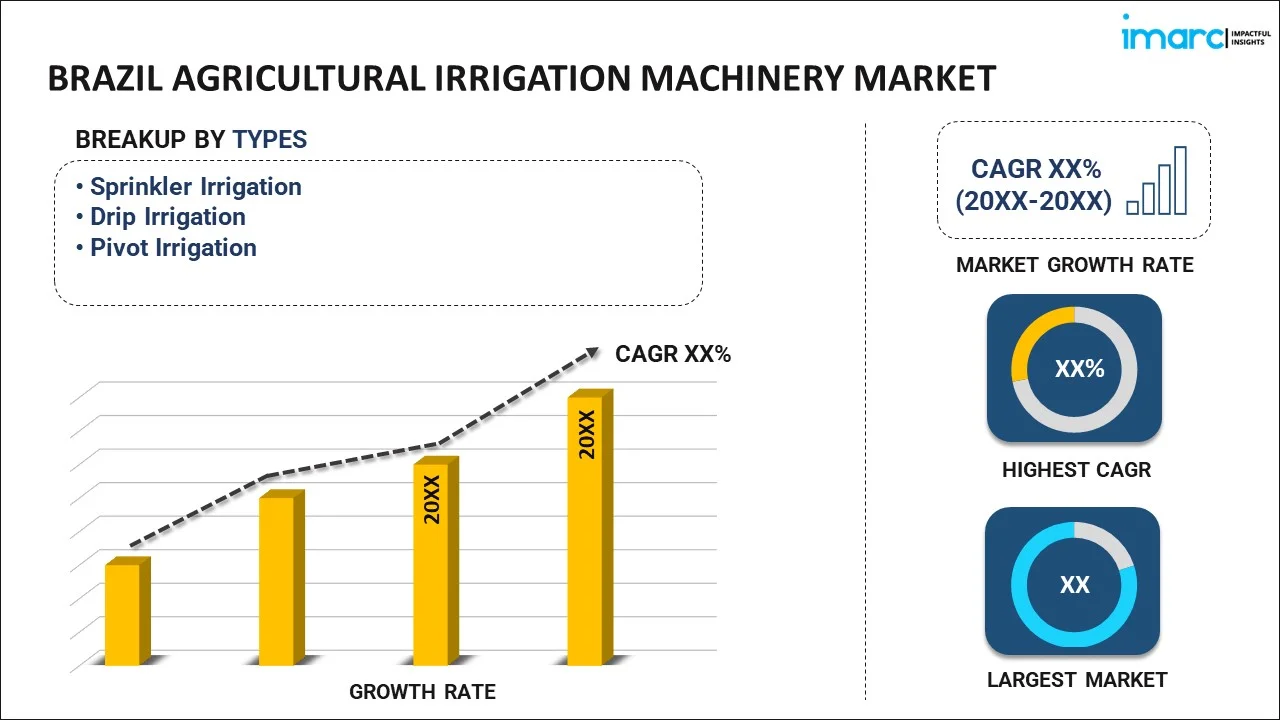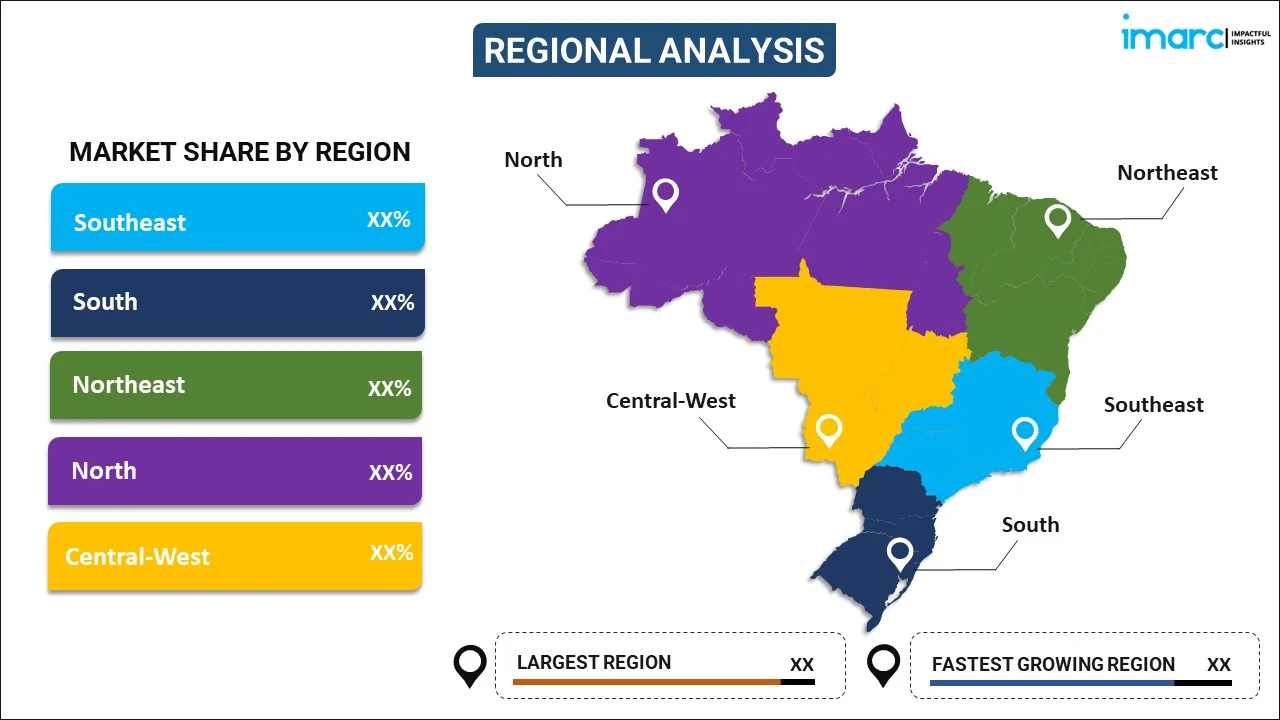
Brazil Agricultural Irrigation Machinery Market Report by Type (Sprinkler Irrigation, Drip Irrigation, Pivot Irrigation), Application (Crop, Non-Crop), and Region 2025-2033
Market Overview:
Brazil agricultural irrigation machinery market size reached USD 97.3 Million in 2024. Looking forward, IMARC Group expects the market to reach USD 162.5 Million by 2033, exhibiting a growth rate (CAGR) of 5.8% during 2025-2033. The rapid expansion of agricultural land and diversification of crops, rising demand for increased crop yields and water resource conservation, and escalating need for resilient irrigation systems represent some of the key factors driving the market.
|
Report Attribute
|
Key Statistics
|
|---|---|
|
Base Year
|
2024 |
|
Forecast Years
|
2025-2033
|
|
Historical Years
|
2019-2024
|
| Market Size in 2024 | USD 97.3 Million |
| Market Forecast in 2033 | USD 162.5 Million |
| Market Growth Rate (2025-2033) | 5.8% |
Agricultural irrigation machinery is specialized equipment and systems designed to deliver water to agricultural fields and crops efficiently. Irrigation is crucial in agriculture as it helps ensure consistent and adequate water supply to plants, particularly in regions with irregular rainfall patterns or arid climates. There are various types of agricultural irrigation machinery, each tailored to specific irrigation methods and crop requirements. Drip irrigation systems deliver water directly to the base of individual plants through a network of tubes and emitters, minimizing water wastage and promoting efficient nutrient delivery. Sprinkler irrigation systems distribute water over crops as droplets, simulating natural rainfall. Center pivot irrigation systems are automated systems that use wheeled sprinklers rotating around a pivot point to efficiently irrigate large, circular farmland areas. Flood or furrow irrigation in which water is manually or mechanically channeled along furrows or basins between crop rows, allowing for even distribution across the field. Subsurface irrigation involves delivering water directly to the root zone of plants below the soil surface, reducing water loss through evaporation, and minimizing weed growth. Agricultural irrigation machinery significantly contributes to food production and global agriculture by ensuring water-efficient and sustainable farming practices, thereby helping meet the increasing demands of a growing population and changing climatic conditions. At present, agriculture machinery finds extensive applications in modern farming by ensuring consistent and adequate water supply to plants, particularly in regions with irregular rainfall patterns or arid climates across Brazil.
Brazil Agricultural Irrigation Machinery Market Trends:
The Brazil agricultural irrigation machinery market is experiencing significant growth, propelled by the rapid expansion of the agriculture sector, which includes a diverse range of crops that necessitates efficient irrigation solutions to optimize yields and mitigate the effects of variable rainfall patterns. Moreover, the growing adoption of modern farming practices, including precision agriculture and controlled irrigation systems, has augmented the demand for advanced machinery. Apart from this, Brazil's commitment to sustainable agriculture and environmental conservation has accelerated the adoption of water-efficient irrigation technologies, thereby driving market growth. Additionally, several favorable government initiatives, subsidies, and incentives for agricultural development that encourage farmers to invest in irrigation machinery is another major growth-inducing factor. Besides this, the increasing availability of financing options and the presence of international manufacturers offering innovative and tailored solutions are fueling market growth. Furthermore, the escalating need to address climate change-related challenges that highlight the importance of advanced irrigation machinery in ensuring food security and sustainable agriculture in Brazil is contributing to market growth.
Brazil Agricultural Irrigation Machinery Market Segmentation:
IMARC Group provides an analysis of the key trends in each segment of the market, along with forecasts at the country level for 2025-2033. Our report has categorized the market based on type and application.
Type Insights:

- Sprinkler Irrigation
- Pumping Unit
- Tubing
- Couplers
- Spray/Sprinklers Heads
- Fittings and Accessories
- Drip Irrigation
- Valves
- Backflow Preventers
- Pressure Regulators
- Filters
- Emitters
- Tubing
- Others
- Pivot Irrigation
The report has provided a detailed breakup and analysis of the market based on the type. This includes sprinkler irrigation (pumping unit, tubing, couplers, spray/sprinklers heads, fittings and accessories), drip irrigation (valves, backflow preventers, pressure regulators, filters, emitters, tubing, others), and pivot irrigation.
Application Insights:
- Crop
- Field Crops
- Vegetables
- Fruits
- Non-Crop
- Turf and Ornamental
- Turf and Ornamental
A detailed breakup and analysis of the market based on the application have also been provided in the report. This includes crop (field crops, vegetables, fruits) and non-crop (turf and ornamental).
Regional Insights:

- Southeast
- South
- Northeast
- North
- Central-West
The report has also provided a comprehensive analysis of all the major regional markets, which include Southeast, South, Northeast, North, and Central-West.
Competitive Landscape:
The market research report has also provided a comprehensive analysis of the competitive landscape in the market. Competitive analysis such as market structure, key player positioning, top winning strategies, competitive dashboard, and company evaluation quadrant has been covered in the report. Also, detailed profiles of all major companies have been provided. Some of the key players include:
- Irritec SpA
- Nelson Irrigação Brasil
- Netafim Brazil
- Rivulis
(Please note that this is only a partial list of the key players, and the complete list is provided in the report.)
Brazil Agricultural Irrigation Machinery Market Report Coverage:
| Report Features | Details |
|---|---|
| Base Year of the Analysis | 2024 |
| Historical Period | 2019-2024 |
| Forecast Period | 2025-2033 |
| Units | Million USD |
| Scope of the Report | Exploration of Historical Trends and Market Outlook, Industry Catalysts and Challenges, Segment-Wise Historical and Future Market Assessment:
|
| Types Covered |
|
| Applications Covered |
|
| Regions Covered | Southeast, South, Northeast, North, Central-West |
| Companies Covered | Irritec SpA, Nelson Irrigação Brasil, Netafim Brazil, Rivulis, etc. |
| Customization Scope | 10% Free Customization |
| Post-Sale Analyst Support | 10-12 Weeks |
| Delivery Format | PDF and Excel through Email (We can also provide the editable version of the report in PPT/Word format on special request) |
Key Questions Answered in This Report:
- How has the Brazil agricultural irrigation machinery market performed so far and how will it perform in the coming years?
- What has been the impact of COVID-19 on the Brazil agricultural irrigation machinery market?
- What is the breakup of the Brazil agricultural irrigation machinery market on the basis of type?
- What is the breakup of the Brazil agricultural irrigation machinery market on the basis of application?
- What are the various stages in the value chain of the Brazil agricultural irrigation machinery market?
- What are the key driving factors and challenges in the Brazil agricultural irrigation machinery?
- What is the structure of the Brazil agricultural irrigation machinery market and who are the key players?
- What is the degree of competition in the Brazil agricultural irrigation machinery market?
Key Benefits for Stakeholders:
- IMARC’s industry report offers a comprehensive quantitative analysis of various market segments, historical and current market trends, market forecasts, and dynamics of the Brazil agricultural irrigation machinery market from 2019-2033.
- The research report provides the latest information on the market drivers, challenges, and opportunities in the Brazil agricultural irrigation machinery market.
- Porter's five forces analysis assist stakeholders in assessing the impact of new entrants, competitive rivalry, supplier power, buyer power, and the threat of substitution. It helps stakeholders to analyze the level of competition within the Brazil agricultural irrigation machinery industry and its attractiveness.
- Competitive landscape allows stakeholders to understand their competitive environment and provides an insight into the current positions of key players in the market.
Need more help?
- Speak to our experienced analysts for insights on the current market scenarios.
- Include additional segments and countries to customize the report as per your requirement.
- Gain an unparalleled competitive advantage in your domain by understanding how to utilize the report and positively impacting your operations and revenue.
- For further assistance, please connect with our analysts.
 Inquire Before Buying
Inquire Before Buying
 Speak to an Analyst
Speak to an Analyst
 Request Brochure
Request Brochure
 Request Customization
Request Customization




.webp)




.webp)












